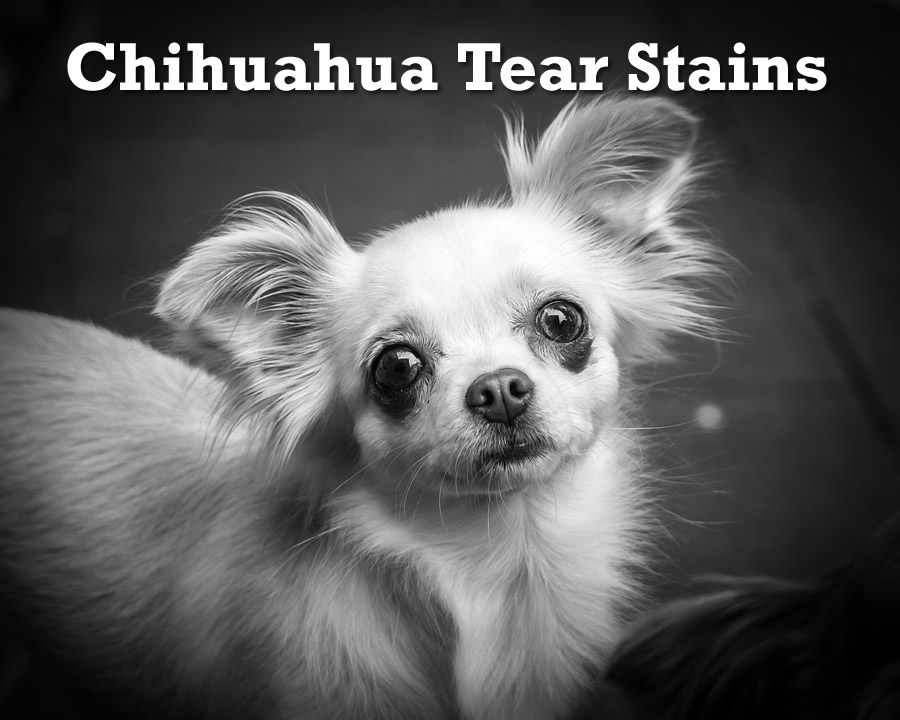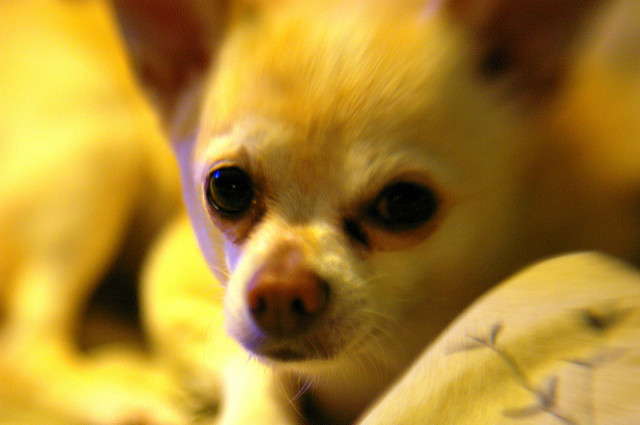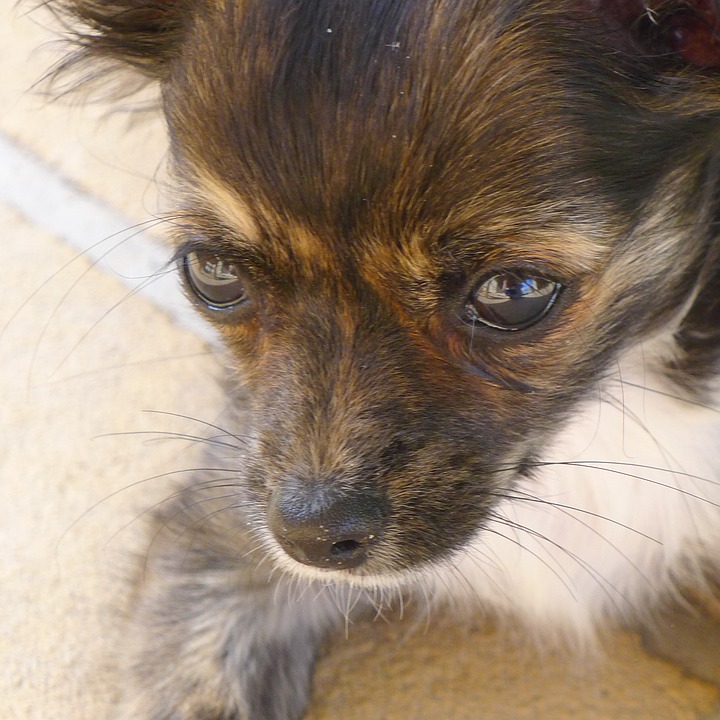
Have you noticed dark-colored tear stains under your Chihuahua’s eyes? Tear staining is a condition that’s characterized by dark reddish-brown stains under the eyes. When a Chihuahua produces tears, those tears may drip below his eyes, creating these distinct stains on his fur.
Some owners disregard tear stains as being nothing more than an “aesthetic” problem with no real cause for concern. This is true in many cases, but in others, it’s a sign of an underlying problem.
Turning a blind eye to what’s causing your Chihuahua’s tear stains could make the problem worse, or it could lead to other problems like a yeast infection. If you’ve noticed tear stains on your Chihuahua, follow the tips below to identify the cause.
Why Tear Stains are Reddish-Brown Colored
Tears are clear, so conventional wisdom may lead you to believe that tear stains are also clear, only revealing the color of the Chihuahua’s fur underneath. While the color of tear stains may vary, most are a dark reddish-brown. So, why aren’t they clear instead?
Tear stains receive their characteristic color from compounds within them. A Chihuahua’s tears are more than just water; they contain mucus, electrolytes, nutrients, and iron-containing molecules known as porphyrins. It’s these porphyrins that create reddish-brown stains through the process of oxidation, similar to the way in which iron and iron-based metal alloys rust over time. When tears drip down a Chihuahua’s face, the iron reacts to light, moisture and air, creating this distinct color.
Red Tear Stains and Yeast Infections
Normally, tear stains have a reddish-brown color (like rust), caused by the oxidation of porphyrins. If your Chihuahua’s tear stains are brown with little-to-no red, however, it could indicate the presence of a yeast infection.
Yeast infections are particularly common among Chihuahuas with tear stains because of the moist fur below their eyes. Yeast pathogens thrive in moist and warm environments, making tear-stained fur ideal for infection. Owners can reduce the risk of yeast infection by cleaning and drying the fur below their Chihuahua’s eyes (see below for more information on cleaning tear stains).
Causes of Tear Stains

According to TheNest, 20 to 25% of all small dogs develop tear stains. While it can affect all dogs, short-nose breeds like the Pekingese, Maltese, Shih-Tzu, pug and Chihuahua have a greater risk because of their shallow eye sockets.
If a dog’s eye sockets are too small or shallow, tears will spill out instead of being flushed through the tear ducts. Also, keep in mind that tear stains are more visible on dogs with a light-colored coat than a dark-colored coat.
Aside from the fact that Chihuahuas are predisposed to tear staining, the most common cause of this condition is an overproduction of tears (known as epiphora). Chihuahuas don’t necessarily cry when upset or frightened, but they will produce tears to lubricate their eyes, protect against foreign objects, improve visual clarity, and nourish their eyes with nutrients. If a Chihuahua suffers from an underlying condition such as infection, blocked tear duct, allergies or irritation, however, he may produce an excessive amount of tears, which leads to tear stains.
Now let’s take a closer look at some of the underlying causes of tear stains in Chihuahuas…
- Conjunctivitis: Also known as pink eye, conjunctivitis is one of the most common causes of excessive tear production and subsequent tear stains in Chihuahuas. It’s characterized by inflammation of the membrane covering the eyeball and inner eyelid (the conjunctiva). In addition to watery eyes, other symptoms of conjunctivitis include eye redness, inflammation, mucus discharge, squinting, and eyelids stuck together. Conjunctivitis is caused by viral and bacterial infections, allergies, irritation, or hereditary conditions. The good news is that most cases of conjunctivitis are easily treated using veterinary-prescribed antibiotics for bacterial infections; antiviral medication for viral infections; and hydrocortisone drops and anti-inflammatory medication for allergies.
- Blocked Tear Duct: In the corner of a Chihuahua’s eyes are narrow ducts through which old tears are flushed. If one or both tear ducts become obstructed with dust, grass particles or other debris, tears will accumulate in the Chihuahua’s eye socket before spilling out. If you believe your Chihuahua has a blocked tear duct, schedule an appointment with your veterinarian. Vets can diagnose blockages by placing fluorescein dye drops in the Chihuahua’s eyes and then inspecting the nostrils to see if it’s being properly flushed. If no blockage is present, the dye will appear in both nostrils. If there’s a blockage in the Chihuahua’s right-eye tear duct, however, the dye will only appear in the left nostril, or vice-versa for blockages in the left-eye tear duct.
- Congenital Defects: Some Chihuahuas are just born susceptible to tear stains. Imperforate lacrimal puncta is a congenital defect in which a dog is born without tear duct openings. Surgery is typically the only treatment option for this defect. Other Chihuahuas are born with narrow tear ducts, making them more prone to blockages. In these Chihuahuas, the veterinarian may recommend flushing the blocked tear duct with a saline solution.
- Entropion: This condition is characterized by the inversion of the eyelid. When a Chihuahua’s eyelid rolls inward and becomes inverted, it causes fur on his eyelid to make direct contact with his eyeball, causing irritation and excess tear production. Entropion can affect either a portion of the Chihuahua’s eyelid or the complete eyelid. It typically affects both eyelids and is associated with aging.
- Allergies. Exposure to common allergens such as tree, plant and weed pollen can also cause tear stains, usually affecting both eyes. For severe allergies, a veterinarian may prescribe steroidal medication like Vanectyl-P. Steroids work by suppressing the immune system, preventing it from going into “overdrive” when it detects an allergen. As a side effect, though, Chihuahuas are more likely to get sick from infection when taking them. Antihistamines like clemastine, chlorpheniramine, and hydroxyzine are used to treat acute allergies in Chihuahuas.
- Glaucoma: Chihuahuas suffering from glaucoma have a greater risk of developing tear stains. Glaucoma is a condition in which excess pressure builds up inside the eyeball, often causing pain, watery eyes and eventually vision loss. It’s either classified as primary when it’s inherited or secondary when other diseases or conditions trigger the pressure buildup. Certain breeds such as the American Cocker Spaniel, Basset Hound, Shar Pei and Jack Russel Terrier are predisposed to glaucoma. Chihuahuas generally have a low risk of developing glaucoma.
- Irritation: Overgrown fur around the eyes is a common problem in long-coat Chihuahuas. When the fur becomes too long, it can poke against the eyeball and trigger excess tear production. Having your Chihuahua professionally groomed on a regular basis can prevent overgrown fur and its associated problems. Both short-coat and long-coat Chihuahuas are susceptible to eye irritation from foreign objects like splinters, grass awns and stray fur.
- Poor Diet: Your Chihuahua’s diet may influence his tear stains. Feeding a Chihuahua low-quality food consisting mostly of heavily processed “filler” ingredients can cause excess porphyrin production. With more porphyrins present in his tears, the Chihuahua will develop stains more easily.
- Unfiltered water. Even the water your Chihuahua drinks can affect his tear stains. Unfiltered tap water often contains iron, fluoride, chlorine, lead and other impurities, so try switching over to filtered or distilled water instead.
How to Treat Tear Stains

The method for treating tear stains varies depending on its underlying cause, and as you can see there are many different causes.
Something as simple as flushing your Chihuahua’s eyes can eliminate tear stains if there’s a blockage. If allergies are to blame, antihistamines or steroids may work. For tear stains caused by conjunctivitis, antibiotics or anti-viral medication is recommended.
Cleaning and Drying Your Chihuahua’s Tear Stains
While it’s best to treat the underlying cause of tear stains, you can provide temporary relief by cleaning and drying your Chihuahua’s stained fur. This serves two purposes: it keeps his coat looking clean, and it reduces the risk of a yeast infection.
The next time you see tear stains on your Chihuahua, soak a cotton ball in lukewarm water — just enough so that it’s damp — and gently blot the stained fur until it comes clean. If the stain has hardened, you may need to gently scrub the area using a moistened paper towel, after which you should go back over the fur with a dry paper towel to eliminate any excess moisture.
Tear Stain Wipes
If water alone isn’t enough to clean your Chihuahua’s tear stains, try using a tear stain wipe. These are single-use wipes that contain special ingredients to safely remove stubborn stains.
When choosing a tear stain wipe, read the ingredients to ensure it doesn’t contain alcohol, sulfates, phosphates or other harsh chemicals. Tear stain wipes should only contain gentle, non-irritating ingredients like water, aloe vera, glycerin, coconut oil, fruit oil, etc.
Also, owners should avoid using the Angels’ Eyes and Angels’ Glow tear stain removal products. The Federal Drug Administration (FDA) issued a warning about these products being sold illegally. According to the FDA’s statement, Angels’ Eyes and Angels’ Glow contain the antibiotic tylosin tartrate, which has not been approved for use in dogs or cats.
What About Vinegar, Hydrogen Peroxide or Other Home Remedies?
We’ve heard reports of owners cleaning their Chihuahua’s tear stains with everything from apple cider vinegar and hydrogen peroxide, to milk of magnesia, Visine and corn starch. Even if home remedies such as these remove stains, we do NOT recommend using them.
Apple cider vinegar and hydrogen peroxide burn the eyes, while corn starch can further obstruct your Chihuahua’s tear ducts. You can add a teaspoon of organic apple cider vinegar to your Chihuahua’s water dish to help flush toxins from his system and balance his pH levels, but you should not apply it directly to his eyes or skin.
Ultimately, you must identify the root cause of your Chihuahua’s tear stains to effectively treat this condition. Drying and cleaning the stains is only a temporary solution, so schedule an appointment with your veterinarian for a professional diagnosis.
How do you manage your Chihuahua’s tear stains? Let us know in the comments section below!
References:
https://www.akc.org/expert-advice/health/tear-stains-prevent-and-clean/
https://healthypets.mercola.com/sites/healthypets/archive/2014/11/12/pet-tear-staining.aspx
https://www.vetstreet.com/care/conjunctivitis-in-dogs-and-cats
I just started really noticing my chihuahuas tear stains. He looks tired all the time. After all the reading and comments, I’m going to clean them everyday a few times a day for a week. If that doesn’t help, I’m going to the vet.
Tear stains both my Tiny boys have them my apple head white has them worse than my deer head tea cup which is brown I’ve always used baby wipes to clean them and it’s never been a problem but reading this it could be our well water because we have iron in it so I’m gonna try the apple cider vinegar in their water and see if it helps! Or just use bottled water! I use apple cider vinegar as flea control because I don’t like using poison and now especially since fleas are becoming resistant I give them a bath twice a week with dish soap then spray apple cider on their coat vacuum daily and comb them daily and the fleas are minimal to none I always comb or brush them after going outside because that’s usually when they get one! They actually had more when I used a monthly topical poison on them! The trick is the brushing and vacuuming! And my babies go everywhere I go! I don’t leave them in the car they go in Walmart, Home Depot everywhere! If they can’t go in I don’t shop there any longer!
Thanks for the facts! I love Chihuahuas
EXACTLY – I bring my babies with me if I am making short trips around town, lock the car, and keep the engine running with the A/C on, even in the heat of Las Vegas, NV.
My only concern is someone stealing my babies, because I am not there, and it doesn’t take but a few moments to break a window, and run off with them.
Go to any good pet store and ask for the best tear stain remover and it works. I use a couple of kinds bought at my pet store. If it doesn’t work you really need to ask your vet they may even sell what you need. Don’t rush into any surgery!
My one Chi, licks my other Chihuahua’s eyes. Can that hurt either dog? She cleans her eyes and ears like she is her momma.
My 2 Chi’s keep licking each other’s tongues. I don’t know why but l stop them.
Hello! My chihuahua is 13 years old (she looks exactly like the blonde chihuahua in the picture above!) and I have kept her moving & exercising. Her mother is almost 17 and is still alive and her father just passed recently. She had the tear thing for YEARS… literally 12.5 years and then out of nowhere it just stopped! Totally disappeared. Right about the same time (maybe shortly after) she started getting bitchy and wouldn’t let us touch her. She has a hunchback and I think it’s affecting her hips and legs… I also noticed she started losing hair on her tail and around her neck. They tested her and she had a low thyroid. We had to give steroids and put a gate up to prevent her from going up and down the stairs. Then we started giving her a CBD oil which helps with pain and joints. She still runs and plays, but then every so often she gets pain again and I have to give her a dose or 2 of steroids… Anyway… even though she is better, her tears have not returned… even her groomer thinks it’s strange!
Vet told me CBD oil not good for them. I have 2 small bottles but never used it. Had there been any side affects? Do you feed it to yours or just apply it?
After 5 months my tiny chihuahuas eyes are tearing up. First time ever!
What can i do to help her with this cycle? She does not play with me like she used to is this because of her cycle? What can i do help
Same happened To my 8 month old chihuahuas I’ll never send it but the difference was the food I was feeding them I was feeding them all a dog and took them to the vet and the vet said they had chicken and turkey allergies and to put them on a salmon with grains taste of the wild diet and that’s what I’ve done I have 3 and a 1/2 that’s actually the problem for their goodbyes In the intern I have to take a warm wash cloth and there’s a little bit of this medicine I think it’s Mia’s then that I got a petsmart 3 times A-day I wiped their eyes and the vet agreed that’s all I can do for now.
My white Chihuahua had ugly tear stains. After expensive tear duct operation, which did nothing, and trying every other treatment, the only thing which worked was Glow Groom. Cannot recommend it highly enough.
Want to know how long do chihuahua’s nails have to be to trim them?
I use a fragrence free wet wipe to clean the tear stains. If the skin under the stain looks red I put a dab of neosporin on the area. Good food helps reduce the staining. I feed “taste of the wild” and tear stains are minimal. And yes they do cry! My Charo cries whenever I leave her in the car to go in a store. She is always temp comfortalbe and sun blocked by visor/screeens etc. She does not cry when my husband has her and leaves her in the car. She’s a mamas’ girl.
Be careful using neosporin repeatedly. Make sure your pet doesn’t develop a rash or allergy from it. Fun fact: if a human uses neosporin continuously for two weeks, she or he will most likely develop an allergic reaction to neosporin!! (And will be allergic to the stuff for the rest of her or his life.)
Please don’t leave your dog in the car. Just don’t bring them with you when shopping and if you cannot take them with you.
Really people. She said she leaves the car running so the dog is comfy. I take mine with me and do the same thing. They love going bye bye.
My dogs love to go bye byes and I used to leave the car on with the air conditioner running. I then started thinking what if something happened to the air conditioner and it stoped. That scared me so I chose not to take them. It’s everybody’s choice and I’m not saying that my way is the best. It was just something that went through my head and it scared me.
Agree!